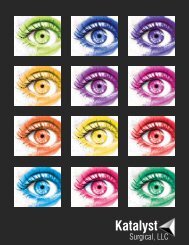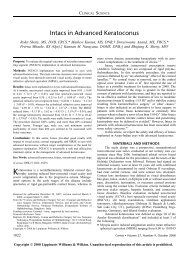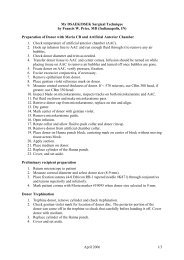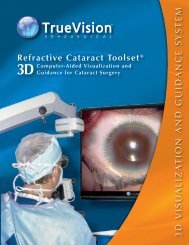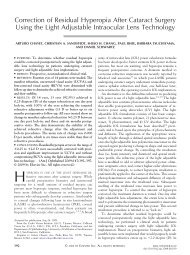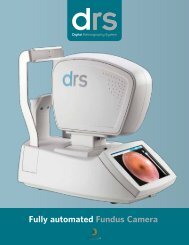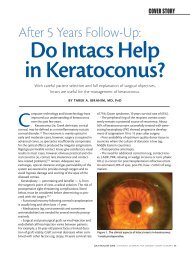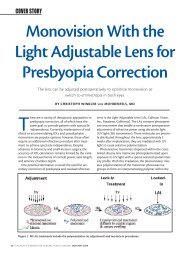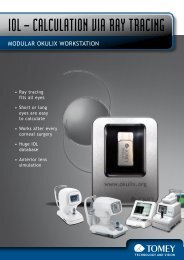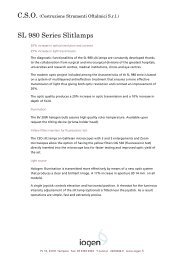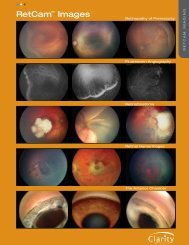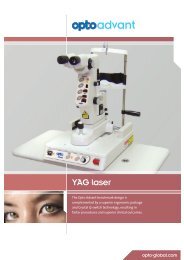Sulcoflex ®Pseudophakic Supplementary IOLs - Iogen
Sulcoflex ®Pseudophakic Supplementary IOLs - Iogen
Sulcoflex ®Pseudophakic Supplementary IOLs - Iogen
You also want an ePaper? Increase the reach of your titles
YUMPU automatically turns print PDFs into web optimized ePapers that Google loves.
<strong>Sulcoflex</strong>® Pseudophakic <strong>Supplementary</strong> <strong>IOLs</strong><br />
found contact between the two IOL materials.<br />
Daniel: I have also never seen any optic-to-optic contact<br />
with this lens.<br />
Körber: I have a question. If the PCO is rather prominent<br />
with production of peripheral Elshnig’s pearls, the<br />
peripheral anterior capsule of the lens will be prominent<br />
and may even displace the <strong>Sulcoflex</strong>®. Has that been<br />
observed, or is it too early to ask?<br />
Amon: In my cases, I have not observed this. But if the<br />
distance between the two <strong>IOLs</strong> would change slightly, I<br />
do not think it would create a problem.<br />
Smith: I think, too, it is rare these days to see pearl formation<br />
in front of the optic. I have seen it a lot behind<br />
the optic of the Akreos lenses (Bausch & Lomb) after<br />
they have had capsulotomies. Rayner’s lenses tend not to.<br />
Claoué: I think that was a problem in pre-capsulorrhexis<br />
days. Now, more lenses have a 360º square-edge<br />
design on the front as well as the back.<br />
ASPHERIC BENEFITS?<br />
Claoué: What does the concave posterior surface of<br />
the optics do to higher-order aberrations?<br />
Amon: That is difficult to answer, but I will mention a<br />
note on asphericity. The lens is neutrally aspheric, meaning<br />
it does not induce any additional aspheric aberration.<br />
That is important because the first lens may already have<br />
some asphericity. So, it is important to have a neutral<br />
lens that does not correct the corneal asphericity if it is<br />
not needed. From the concave point of view, however, I<br />
cannot answer.<br />
Claoué: These lenses are very low power, at least in<br />
terms of spherical error. And, low spherical lenses have<br />
very low spherical aberration. I am not quite convinced<br />
how important having an aspheric is. I am going to continually<br />
ask the manufacturers to customize aspheric corrections<br />
for individual eyes. To me, it is amazing that we<br />
accept a single variety of asphericity from manufacturers.<br />
However, because these are mainly low-powered lenses, I<br />
think that the degree of asphericity may actually not be<br />
that important.<br />
Smith: I agree, asphericity is not that important. When<br />
you look at the enormous experience with nonaspheric<br />
<strong>IOLs</strong> and the excellent vision that they yield—and now<br />
that there are at least three levels of aspheric lenses on<br />
8 I SUPPLEMENT TO CATARACT & REFRACTIVE SURGERY TODAY EUROPE I NOVEMBER/DECEMBER 2009<br />
the market—you struggle to perceive a difference in clinical<br />
outcomes. I know this notion of customization is<br />
available, but for the most part, I think it is relatively<br />
unimportant.<br />
Körber: I am more or less on the same wavelength.<br />
Daniel: I agree as well, there is no advantage.<br />
Amon: Yes, me too. The question is for the depth of<br />
field. To tell the truth, I know the principle but I do not<br />
know what impact it has for the patient.<br />
Claoué: We have been referring to our experience with<br />
patients, but we must also look at the evidence. Johansson’s<br />
multicenter Swedish study confirmed patient appreciation<br />
for aspheric <strong>IOLs</strong>. 2 Half of patients enrolled in the study<br />
could not tell which eye had the high negative aberration<br />
lens and which had the zero aberration lens. These results<br />
either implied that reducing spherical aberration may not<br />
be important in most patients or that these lenses were not<br />
adequately customized to the patient to show an effect. In<br />
the remaining half of patients, twice as many preferred the<br />
zero aberration to the negative aberration lens. This study<br />
suggests that a standard negative spherical aberration lens is<br />
not a good idea. That has been supported by Denoyer, 3<br />
who has shown that the high negative spherical aberration<br />
lens is better for night driving. However, for activities of daily<br />
vision, the zero spherical aberration lens is better.<br />
I am demanding a customized lens, but I accept that in<br />
2009 and 2010 the best IOL has zero spherical aberration.<br />
Smith: I agree with you, and I do not use negative<br />
spherical aberration lenses. I think it is pushing that issue<br />
too far. In a way, we have only fairly recently arrived at<br />
the use of <strong>IOLs</strong> that tailor sphero-cylindrical refractive<br />
error.<br />
Claoué: I agree. We still are exploring toric and toric<br />
multifocal <strong>IOLs</strong>. To some extent, it could be argued that<br />
we must explore these lenses first before we move on to<br />
higher-order aberrations. It would seem logical to correct<br />
Zernike 1 and 2 before we move to correct higher-order<br />
aberrations.<br />
MULTIFOCAL SULCOFLEX®<br />
Claoué: Michael, please tell us about the different<br />
optics you would like to see or have seen on the <strong>Sulcoflex</strong>®<br />
platform.<br />
Amon: We now have three options. A monofocal neutral<br />
aspheric lens; the toric version; and the multifocal



